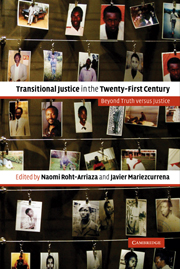Book contents
- Frontmatter
- Contents
- List of contributors
- Acknowledgments
- The new landscape of transitional justice
- Part I Truth, justice, and multiple institutions
- Part II Levels of justice: Local, national and international
- Introduction to Part II
- 7 A new approach to restorative justice – East Timor's Community Reconciliation Processes
- 8 Justice at the grassroots? Gacaca trials in Rwanda
- 9 Bremer's “Gordian Knot”: Transitional justice and the US occupation of Iraq
- 10 Truth, justice and stability in Afghanistan
- 11 The prosecution of Hissène Habré: International accountability, national impunity
- 12 Argentina's contribution to global trends in transitional justice
- 13 Transitional justice: Lessons learned and the road ahead
- Index
7 - A new approach to restorative justice – East Timor's Community Reconciliation Processes
Published online by Cambridge University Press: 05 June 2012
- Frontmatter
- Contents
- List of contributors
- Acknowledgments
- The new landscape of transitional justice
- Part I Truth, justice, and multiple institutions
- Part II Levels of justice: Local, national and international
- Introduction to Part II
- 7 A new approach to restorative justice – East Timor's Community Reconciliation Processes
- 8 Justice at the grassroots? Gacaca trials in Rwanda
- 9 Bremer's “Gordian Knot”: Transitional justice and the US occupation of Iraq
- 10 Truth, justice and stability in Afghanistan
- 11 The prosecution of Hissène Habré: International accountability, national impunity
- 12 Argentina's contribution to global trends in transitional justice
- 13 Transitional justice: Lessons learned and the road ahead
- Index
Summary
Introduction
Like the basic principle of supplying medical aid in emergencies, the primary goal of all transitional justice initiatives must be to first avoid the occurrence of additional violations. While preventing further injury we can also try to heal the wounds which have already been sustained. Punishing those responsible for past violations, preventing them from repeating these in the future, providing a clear deterrent message to others who may be tempted to act in a like manner, and providing some solace to victims by demonstrating that those who caused their suffering will also suffer, are of major importance in this context. They are not, however, the complete picture.
Accountability may be the most essential ingredient to healing the past, but it is the total answer to neither justice nor reconciliation. Punishment will not by itself heal the past wounds, which are so commonly the cause of renewed hostilities and the occurrence of new violations. A serious approach to this challenge needs to be holistic. Despite the overwhelming obstacles, significant advances have been made in recent years towards building mechanisms to provide accountability, but there has been far less progress towards understanding or creating practical mechanisms that promote reconciliation.
Many conflicts take place in societies in which the role of formal policing and legal systems has been negligible or, taken at its best, provided a minimal contribution towards law and order; in others they have been the tools of abuse. This does not mean that there is anarchy.
- Type
- Chapter
- Information
- Transitional Justice in the Twenty-First CenturyBeyond Truth versus Justice, pp. 176 - 205Publisher: Cambridge University PressPrint publication year: 2006
- 12
- Cited by



